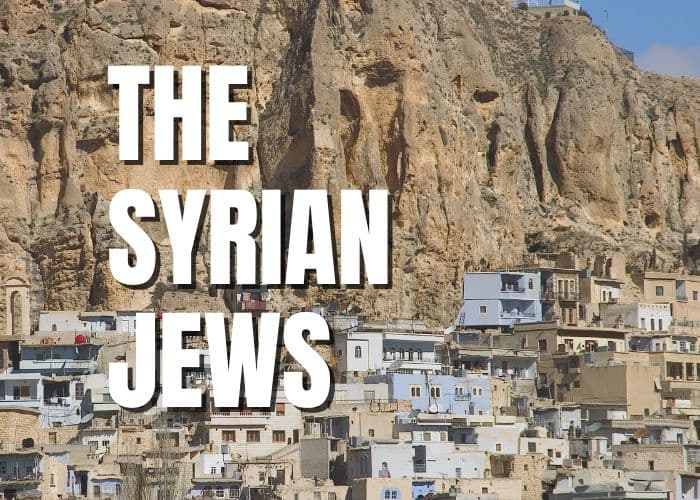The Syrian Jewish community is one of the oldest and most historic Jewish communities in the world, with a rich cultural and religious heritage that spans thousands of years. This community has played a significant role in shaping the cultural and economic landscape of the Middle East, particularly in Syria, where Jews were once a thriving and influential minority. Today, Syrian Jews can be found in communities all over the world, but their history and traditions remain deeply rooted in Syria.
- History:
Syrian Jews trace their roots back to biblical times, when Jews first began settling in the region that is now Syria. Over the centuries, the community grew and prospered, becoming an important center of Jewish learning and scholarship. In the early 20th century, the Jewish community in Syria numbered over 30,000 people, making it one of the largest Jewish communities in the Middle East.
However, the situation for Syrian Jews began to deteriorate in the mid-20th century, as tensions between Jews and Arabs in the region grew. Many Jews were forced to leave Syria due to persecution and violence, and by the 1990s, only a few hundred Jews remained in the country. Today, most Syrian Jews live in Israel or the United States, although there are also significant communities in Mexico and South America.
- Communities Today:
Despite the challenges faced by the Syrian Jewish community, its traditions and culture have survived and continue to be passed down to younger generations. Today, Syrian Jews can be found in communities around the world, with particularly large populations in New York City, Los Angeles, and Israel.
In these communities, Syrian Jews have established their own synagogues, schools, and cultural organizations, where they can practice their religion and preserve their cultural heritage. These organizations play an important role in connecting Syrian Jews with one another and maintaining a sense of community and identity.
- Culture:
Syrian Jewish culture is a rich blend of Jewish, Middle Eastern, and Mediterranean traditions, with a unique flavor that sets it apart from other Jewish communities. Music and cuisine are two important aspects of Syrian Jewish culture, and both have been heavily influenced by the region’s history and geography.
Syrian Jewish music is characterized by its lively rhythms and haunting melodies, with a mix of Hebrew, Arabic, and Aramaic lyrics. Traditional Syrian Jewish songs often tell stories of Jewish life in the region and express the community’s longing for their homeland.
Syrian Jewish cuisine is similarly rich and flavorful, with a mix of Middle Eastern and Mediterranean influences. Dishes like kibbeh (ground meat mixed with bulgur wheat) and stuffed grape leaves are staples of Syrian Jewish cuisine, as are various types of flatbread and dips like hummus and baba ghanoush.
- Religious Liturgy:
Religion is a central aspect of Syrian Jewish life, and the community’s religious traditions are deeply rooted in the region’s history and culture. Syrian Jews follow the Sephardic tradition of Judaism, which emphasizes the importance of education, scholarship, and adherence to Jewish law.
The liturgy of Syrian Jewish prayer services is characterized by its beautiful melodies and intricate choreography. Syrian Jewish synagogues also feature unique architectural and design elements, such as intricate tile work and ornate chandeliers.
- Notable People and Accomplishments:
Syrian Jews have made significant contributions to a wide range of fields, from business and finance to politics and the arts. Here are just a few examples of notable Syrian Jews:
- Sassoon family: This wealthy and influential family of Jewish traders and financiers played a major role in the development of the Middle East’s economy in the 19th and early 20th centuries.
- Farid al-Atrash: This Syrian Jewish musician and actor was a major figure in Arabic music in the mid-20 century. Born in Suwayda, Syria in 1915, al-Atrash moved to Egypt in the 1930s and became a prolific composer, singer, and instrumentalist, known for his fusion of Western and Arabic musical styles. He went on to become a prominent film actor, starring in several Egyptian and Syrian productions.
- Another notable Syrian Jewish musician is Simon Shaheen, a virtuoso oud player, violinist, and composer. Born in Tarshiha, Palestine (now Israel) in 1955, Shaheen grew up in a family of musicians and learned to play the oud at a young age. He later studied Western classical music at the Manhattan School of Music in New York City, and has since performed extensively in both classical and Arabic music genres.
- In the field of literature, Elias Canetti is a notable figure. Born in Ruse, Bulgaria in 1905 to a Sephardic Jewish family from Ottoman Syria, Canetti spent much of his childhood in England and Switzerland before settling in Vienna in the 1920s. He later moved to London and eventually settled in Zurich, Switzerland. Canetti is best known for his novel “Auto-da-Fé” and his memoir “The Tongue Set Free,” which explore themes of power, identity, and the human psyche.
- Other notable Syrian Jews include Eddie Antar, founder of the Crazy Eddie electronics store chain in the United States, and Steven Spielberg, the renowned filmmaker who is of Syrian Jewish descent on his mother’s side.
The history and culture of Syrian Jews is a rich and complex topic that continues to be studied and celebrated today. Despite the challenges and hardships they have faced over the centuries, Syrian Jews have made significant contributions to many fields and have maintained a strong sense of identity and community throughout their history. Their legacy serves as a testament to the resilience and strength of the Jewish people, and their ongoing commitment to preserving their heritage and traditions.








Ohr HaChaim Yomi – Emor